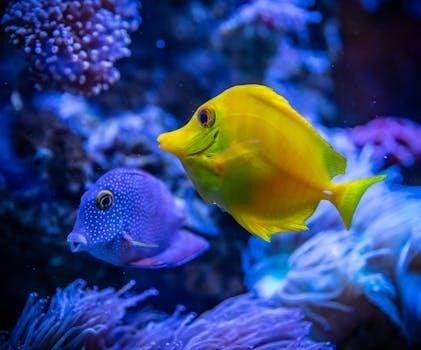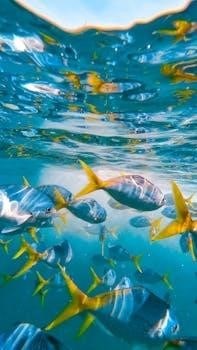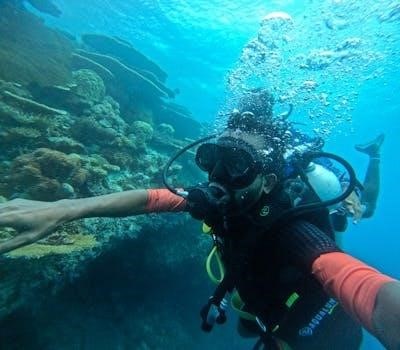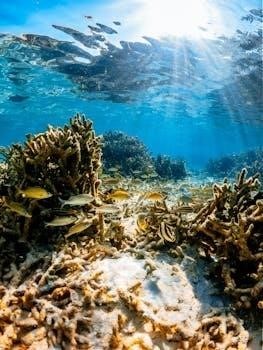
Coral Identification⁚ A Comprehensive Guide
Welcome to the world of coral identification! This comprehensive guide will help you navigate the diverse and fascinating realm of corals. We’ll explore key characteristics for distinguishing various coral species, aiding aquarists, divers, and researchers alike in understanding these vital reef ecosystems.
Coral identification is crucial for reef enthusiasts, marine biologists, and conservationists. Understanding the differences between coral species allows for effective monitoring of reef health and biodiversity. Accurate identification is also essential for responsible reef keeping, ensuring proper care and preventing the spread of diseases. This guide aims to provide a foundation for identifying corals, starting with the basics.
The identification process can be challenging, especially underwater. Factors like water clarity, lighting conditions, and coral color variations can complicate matters. However, by focusing on key morphological features, such as growth form, polyp size, and skeletal structure, one can learn to distinguish between different coral species. This guide will cover various identification techniques, helping you to confidently identify corals in the field or in your aquarium.
We’ll delve into the differences between hard and soft corals, explore coral identification by growth form, and provide specific guidance for identifying SPS, LPS, and soft corals. You’ll also learn about common coral species, the challenges posed by color variations, and the tools and resources available to aid in your identification journey. Get ready to explore the captivating world of coral identification!
Hard vs. Soft Corals⁚ Key Differences
The first step in coral identification is distinguishing between hard and soft corals. Hard corals, also known as stony corals, are the reef builders. They possess a rigid skeleton made of calcium carbonate, which forms the foundation of coral reefs. These corals typically have polyps with six-fold symmetry (hexaradial), meaning their tentacles are arranged in multiples of six. Their growth forms vary widely, including branching, massive, encrusting, and plate-like structures.
Soft corals, on the other hand, lack a hard, calcified skeleton. Instead, they have an internal skeleton made of protein and calcareous spicules. These spicules provide support and give soft corals their characteristic texture. Soft corals generally have polyps with eight-fold symmetry (octaradial), with eight tentacles surrounding the oral disc. They often exhibit branching, encrusting, or fleshy growth forms, swaying gracefully in the water current.
Visually, hard corals tend to have a more structured and rigid appearance, while soft corals appear more flexible and flowing. The presence or absence of a hard skeleton is the defining difference. Understanding this fundamental distinction is crucial for accurately identifying corals and appreciating their diverse roles in the reef ecosystem.
Coral Identification by Growth Form
Coral growth form is a crucial characteristic used in identification, offering a visual starting point before examining finer details. Branching corals, as the name suggests, exhibit a tree-like structure with numerous branches extending from a central base. Staghorn and Elkhorn corals are prime examples of this growth form. Massive corals, like brain corals, form large, boulder-like structures, often with intricate surface patterns.
Encrusting corals grow as thin layers over rocks or other surfaces, conforming to the shape of the substrate. Plate corals form flattened, plate-like structures, often arranged in tiers or spirals. Foliose corals resemble leafy structures, with thin, convoluted folds that increase surface area. Mushroom corals are solitary corals with a distinct mushroom shape, typically lying unattached on the seabed.
Digitate corals resemble fingers or clumps of fingers, growing upwards from a base. Knowing these common growth forms significantly narrows down identification possibilities. Remember that environmental factors influence coral morphology, so growth form alone isn’t definitive but a vital clue in the identification process. Observe the overall shape and structure carefully to begin your identification journey.
SPS Coral Identification
SPS, or Small Polyp Stony corals, present a challenge in identification due to their often subtle differences. Acropora, a dominant SPS genus, showcases diverse branching patterns, from delicate, thin branches to thick, sturdy ones. Montipora corals exhibit encrusting, plating, and branching forms, with varying surface textures, including smooth, bumpy, and ridge-like appearances.
Porites corals often form massive or encrusting structures, characterized by small, closely packed polyps. Seriatopora corals display delicate, bird’s nest-like branching structures. Identifying SPS corals requires close examination of polyp size, shape, and arrangement. Branch thickness, growth pattern, and the presence or absence of axial corallites (dominant polyps at branch tips) are crucial details.
Water flow and lighting significantly affect SPS coral morphology, making identification trickier. Observe the coral’s coloration, but remember that color can vary with lighting and water parameters. Using a magnifying glass or macro lens aids in examining the fine details of the coral’s skeletal structure. Consulting reliable identification guides and comparing multiple specimens are essential for accurate SPS coral identification.
LPS Coral Identification
LPS, or Large Polyp Stony corals, are generally easier to identify than SPS corals due to their larger polyp size and more distinct skeletal features. Brain corals, such as Diploria and Platygyra, exhibit characteristic maze-like patterns on their surfaces. Bubble corals, like Plerogyra sinuosa, are easily recognized by their large, bubble-like vesicles that inflate during the day.
Elegance corals, Catalaphyllia jardinei, possess long, flowing tentacles with vibrant colors. Torch corals, Euphyllia glabrescens, display thick, tubular tentacles that sway in the water. Hammer corals, Euphyllia ancora, have anchor-shaped tentacle tips.

Identifying LPS corals relies on observing polyp shape, size, and color, as well as the skeletal structure. The arrangement of polyps, the presence of septa (vertical plates inside the corallite), and the overall growth form are important characteristics. Favia and Favites corals, often called “moon corals,” can be distinguished by their individual corallite walls (Favia) or shared walls (Favites). Open brain corals, Trachyphyllia geoffroyi, feature a distinct, lobed shape with fleshy polyps. Careful observation and reference to reliable guides will greatly assist in accurate LPS coral identification.
Soft Coral Identification
Soft corals, unlike their stony counterparts, lack a hard, calcium carbonate skeleton, relying instead on proteinaceous materials and sclerites (small, spicule-like structures) for support. This gives them a flexible, often flowing appearance, making them distinct in reef environments.
Identification of soft corals hinges on several key features. Observe the colony’s growth form⁚ some, like tree corals (e.g., Sinularia), branch extensively, while others, such as mushroom leathers (e.g., Sarcophyton), form a distinct capitate shape. The texture of the coral is also important; some are smooth, while others are bumpy or hairy.
Sclerites, though microscopic, play a role in identification. Their shape and color vary between species, though this often requires microscopic analysis. Polyp arrangement is another factor. Some soft corals, like Xenia, have polyps that pulsate rhythmically, while others, such as Cladiella, have densely packed polyps. Coloration can be helpful but variable. Remember to note any unique characteristics, such as the presence of zooxanthellae or specialized structures. Combining observations of growth form, texture, and polyp characteristics allows for effective soft coral identification.

Common Coral Species and Their Identification
Navigating the vast diversity of coral species can be daunting, so let’s explore some common examples and their distinguishing features. Acropora, a prevalent SPS coral, is known for its branching or table-like growth and small, uniform polyps. Montipora, another SPS genus, exhibits diverse forms, including encrusting, plating, and branching varieties, often with textured surfaces.
Among LPS corals, Euphyllia (Torch, Hammer, Frogspawn) are popular for their flowing tentacles with distinct tip shapes. Blastomussa corals display fleshy polyps and come in vibrant colors. Soft corals like Xenia are easily recognized by their pulsing polyps, while leather corals (Sarcophyton, Sinularia) have characteristic leathery textures and variable shapes.
For accurate identification, observe the coral’s growth form (branching, encrusting, etc.), polyp size and shape, and overall texture. Consider the coral’s color, although this can be influenced by lighting and water conditions. Note any unique features, such as the presence of sweeper tentacles or specific polyp arrangements. Utilizing online resources, field guides, and expert consultations can further refine your identification skills, ensuring you accurately recognize these common coral species.
Coral Color Variations and Identification Challenges
Coral identification can be significantly complicated by color variations within the same species. Environmental factors like light intensity, water quality, and nutrient levels profoundly impact coral pigmentation. For instance, a coral under intense lighting might exhibit brighter colors compared to one in shaded areas; Similarly, differences in trace elements can lead to diverse color morphs within a single species.
Bleaching, a stress response where corals expel symbiotic algae, dramatically alters coloration, often causing corals to turn white or pale. This makes identification based solely on color unreliable. Moreover, some corals exhibit color variations due to genetic differences, leading to naturally occurring morphs that can be mistaken for distinct species.

To overcome these challenges, consider multiple characteristics beyond color, such as growth form, polyp structure, and skeletal features. Cross-reference your observations with reliable identification guides and online resources. Consulting with experienced reefers or marine biologists can also provide valuable insights. Remember that color should be a supporting, not a primary, factor in coral identification, especially given the dynamic nature of coral pigmentation.
Tools and Resources for Coral Identification
Accurate coral identification relies on a combination of keen observation and the right tools and resources. A magnifying glass or a microscope is essential for examining the fine details of coral structures, such as corallite shape and septal arrangement. Underwater cameras with macro lenses can capture detailed images for later analysis and comparison.
Several comprehensive coral identification guides are available, both in print and online. These guides often include detailed descriptions, photographs, and illustrations of various coral species. Online databases, such as the World Register of Marine Species (WoRMS) and specialized coral identification websites, provide access to a wealth of information and images.
For aquarists, reef forums and online communities can be invaluable resources. Experienced reef keepers can offer insights and assistance with identification challenges. Additionally, consider attending workshops or seminars led by marine biologists or coral experts. These events provide opportunities to learn from professionals and network with other coral enthusiasts. Remember to critically evaluate information from various sources and cross-reference findings to ensure accuracy.
Coral Diseases and Pests⁚ Identification and Impact
Coral reefs face numerous threats, including diseases and pests that can significantly impact coral health and biodiversity. Accurate identification of these issues is crucial for effective management and treatment. Common coral diseases include coral bleaching, often caused by elevated water temperatures, and various bacterial infections that manifest as lesions or tissue loss. These diseases can spread rapidly, decimating entire coral colonies.
Pests such as crown-of-thorns starfish (Acanthaster planci) and coral-eating snails can also inflict significant damage. Crown-of-thorns starfish are voracious predators that consume coral tissue, leaving behind bare skeletons. Similarly, certain snail species target specific coral types, causing localized damage and weakening the overall reef structure.
Early detection and identification of coral diseases and pests are essential for implementing appropriate interventions. Monitoring reefs regularly for signs of disease or infestation can help prevent widespread outbreaks. Treatment options may include removing infected corals, applying antibiotics, or controlling pest populations. Understanding the specific diseases and pests affecting corals is vital for developing effective conservation strategies and protecting these valuable ecosystems.
Coral Conservation and Responsible Reefing
Coral reefs are facing unprecedented threats from climate change, pollution, and unsustainable practices, making conservation efforts more critical than ever. Responsible reefing practices play a crucial role in protecting these delicate ecosystems and ensuring their survival for future generations. One of the most significant actions is reducing your carbon footprint to mitigate climate change, which is a primary driver of coral bleaching and ocean acidification.

When engaging in reef-related activities, such as diving or snorkeling, it is essential to be mindful of your impact. Avoid touching or disturbing corals, as physical contact can damage their delicate tissues. Choose reef-safe sunscreens that do not contain harmful chemicals like oxybenzone and octinoxate, which can contribute to coral bleaching.
For aquarium enthusiasts, responsible coral acquisition and care are paramount. Purchase corals from reputable sources that practice sustainable harvesting or propagation. Quarantine new corals to prevent the introduction of diseases and pests into your aquarium and, subsequently, potentially into the wild. By adopting these practices, we can collectively contribute to the conservation of coral reefs and promote a more sustainable future.